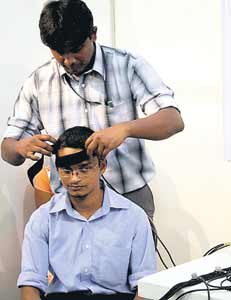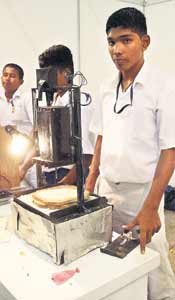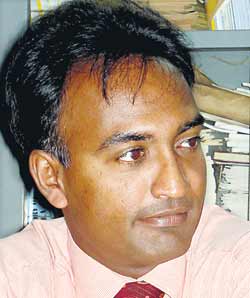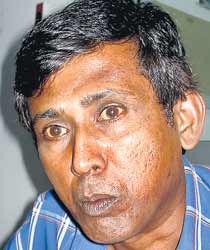
| Creative inventors and support mechanisms H. M Sugathadasa, an inventor from Anuradhapura had to mortgage his house to find money to develop his machine and was on the verge of bankruptcy. Sugathadasa’s invention was a wall scrapper which made the traditional work which required lot of manual labour and material such as scaffoldings a thing of the past. However finding an investor was not easy for him. When he came to the Inventions Commission he was desperately looking for an investor but the way he marketed his product from Anuradhapura didn’t attract any investors.
At the exhibition where a finished product of the prototype of Sugathadasa’s invention was displayed three investors wanted to buy his model. At present the commission is helping Sugathadasa to negotiate with the investors and obtain the best deal for his efforts. S. S. R. Jayathilaka is another successful inventor who is finally able to reap the profits of his hard work and dedication to his work. Jayathilaka, a university dropout, has six successful inventions to his credit and portrays a hope for Sri Lanka’s future.
His latest invention is a machine used to make high quality electronic printed circuit boards (PCB) with minute integrated circuit (IC) components mounted on them, a high tech product which is a first for Sri Lanka and one of the most advanced of the typ in the world. This machine is capable of handling four tasks: screen printing, film processing, screen exposing, and chemical embossing of letters and pictures on metal and glass surfaces whereas the machines that are available in the market now can handle only one or two of them at a time. He has been looking for a buyer for about eight years with only the prototype as a model but no one has come forward to invest on it. Unfortunately he was not able to convince any inventor of the value of his product using on a prototype. This is where the Inventions Commission stepped into help him. “I came to the Invention Commission since the time I invented the film. Then I was awarded Rs 2.7 million but I had to go through a lot of difficulties to get it. It went from one ministry to the other and from ministers to other officials. Finally I got Rs 200,000 as a grant and after that I was so disillusioned that I did not want to come to the Inventions Commission for any thing. No one was willing to help me even and there were many empty promises made to me. I came only when this programme was initiated because one of my colleagues directed me to the Commission,” said Jayathilaka of all the experience he faced. Jayathilaka was directed to the University of Moratuwa where he had access to the assistance of many experts in the field of electronics. The Commission has spent nearly Rs 2 million on incubation of the product. The Department of Electronics of University of Moratuwa did the development of the product to the finished level. He was finally able to find orders and he has already sold two machines and he has got more orders for new machines. According to the Inventions Commission the market price of a machine with two features is around Rs. 6.5 million. However, the new machine with all four features is planned to be priced around Rs. 3 million. So far the local electronics industry suffered from the high cost involved in manufacturing high quality PCBs that made them lose out to Chinese competitors. With the new machine, Sri Lanka has new hopes of reviving the industry.
Jayathilaka and Sugathadasa are two of the Invention Commission’s many success stories. The Commission which was established in 1979 took a new direction under the leadership of Dr. Thrishantha Nanayakkara who took office as the Commissioner in 2005. Since its incorporation till 2005 the emphasis of the Commission has been on setting up inventors circles in the schools and organizing the national inventors’ exhibition and sending a selected number of inventors to participate in international exhibitions like Geneva, Japan and Malaysia. Primarily this was an activity confined to schools. However from 2005 the Commission has put a lot of emphasis on commercialisation. “Of course we increased the number of inventor circles in schools. We increased the number from 2200 to 6000. What we did was we came to an understanding with the Ministry of Education to set up inventor circles in all the schools which have classes above grade six. We had district level coordinators but we didn’t have additional staff; we managed from the 16 staff members we already had. We asked each staff member to take care of one area which they did voluntarily. For example a person working as a driver would also take care of one area. We also held district level exhibitions in 2005 and 2006 and identified good ideas,” said Nanayakkara speaking of the activities the Commission has undertaken. According to him the problem most of these good ideas had is that even thought the ideas are powerful the prototypes are weak so an investor cannot make a commercial decision. “We wanted to incubate these proto type ideas to finished product levels but these people do not have the money or the technology to do this most of the time, so what we did was we gave money to the universities to develop these prototypes,” said Nanayakkara. The Commission allocated Rs 30 million on a pilot trial to Moratuwa University but could only use Rs 12 million because the Treasury has not released the money. With the money the university brought the prototypes to finished level where the investor could make a decision. The university was able to optimise on the ideas and apply the scientific and technical knowledge to have the best finished products.
At the exhibition “Opportunities 2006” which was held last December finished products of the pilot project were exhibited. Through the exhibition investors were able to pick up new ideas for their investments and the universities and the inventors themselves were able to establish ties with the investors, which is really important. Almost all the inventors had met at least two investors. The Commission also helps designers of the products with negotiations with the investor and buyers of the designs. This is a great relief to many designers who are not competent in English, the medium in which many investors negotiate. On the other hand the Commission has also funded some of the projects of the undergraduates which have given amazing results. One such project exhibited is a facility to capture brain waves commonly known as EEG waves; the result was the creation of a high tech head band which is called a minimal invasive headband for brainwave capturing. “There are brainwave capturing devices at major hospitals in Sri Lanka but our one was designed by ourselves and it’s cheap compared to the ones in the market now. We want to show that real complex stuff can be done here too if funding is available. Normally only few large companies in the world produce these equipments,” said Lashan Sasika Bartholomuez of the Electronic and Telecommunication Engineering Department of the University of Moratuwa who was a member of the project. When asked about the future plans for the project they undertook, Bartholomuez said that they have not got an investor yet probably since there is a risk involved in investing in this type of projects. But he is confident that if someone invests the chances of a good return is high. |
| || Front
Page | News
| Editorial
| Columns
| Sports
| Plus
| Financial
Times | International
| Mirror
| TV
Times | Funday
Times | MediScene || |
| |
Copyright
2007 Wijeya
Newspapers Ltd.Colombo. Sri Lanka. |



